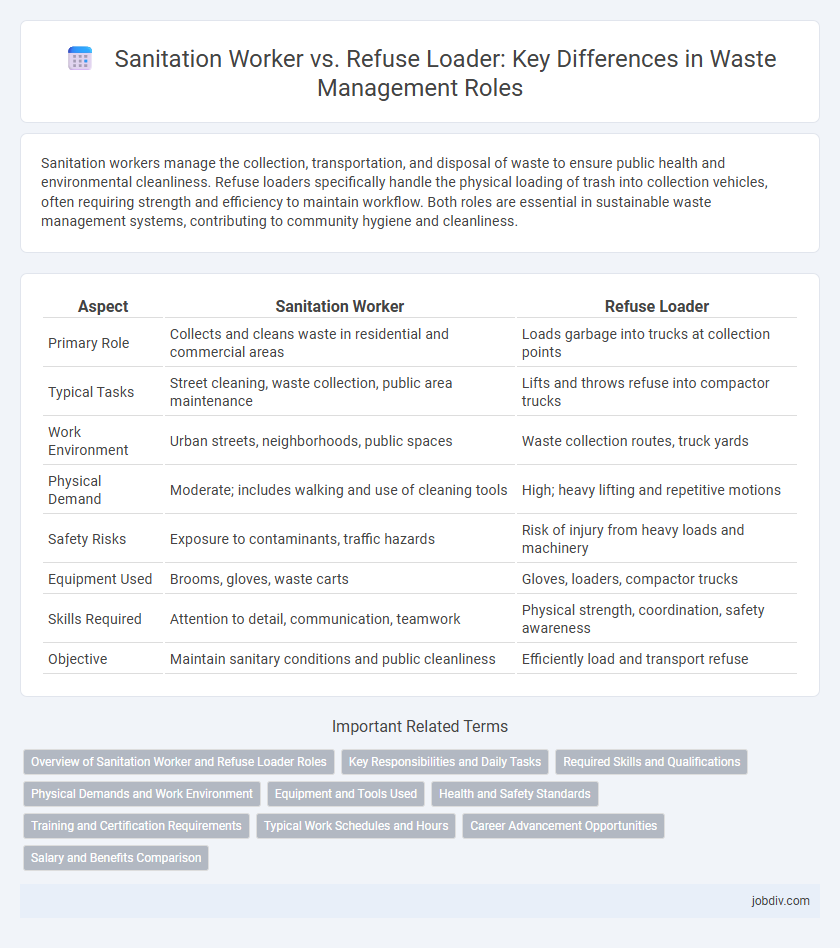Sanitation workers manage the collection, transportation, and disposal of waste to ensure public health and environmental cleanliness. Refuse loaders specifically handle the physical loading of trash into collection vehicles, often requiring strength and efficiency to maintain workflow. Both roles are essential in sustainable waste management systems, contributing to community hygiene and cleanliness.
Table of Comparison
| Aspect | Sanitation Worker | Refuse Loader |
|---|---|---|
| Primary Role | Collects and cleans waste in residential and commercial areas | Loads garbage into trucks at collection points |
| Typical Tasks | Street cleaning, waste collection, public area maintenance | Lifts and throws refuse into compactor trucks |
| Work Environment | Urban streets, neighborhoods, public spaces | Waste collection routes, truck yards |
| Physical Demand | Moderate; includes walking and use of cleaning tools | High; heavy lifting and repetitive motions |
| Safety Risks | Exposure to contaminants, traffic hazards | Risk of injury from heavy loads and machinery |
| Equipment Used | Brooms, gloves, waste carts | Gloves, loaders, compactor trucks |
| Skills Required | Attention to detail, communication, teamwork | Physical strength, coordination, safety awareness |
| Objective | Maintain sanitary conditions and public cleanliness | Efficiently load and transport refuse |
Overview of Sanitation Worker and Refuse Loader Roles
Sanitation workers primarily collect, transport, and dispose of waste and recyclables to maintain public health and cleanliness. Refuse loaders assist this process by manually loading garbage into collection vehicles, often working closely with sanitation workers to ensure efficient waste removal. Both roles are essential in urban waste management systems, emphasizing teamwork and physical labor in maintaining sanitary environments.
Key Responsibilities and Daily Tasks
Sanitation workers primarily focus on cleaning streets, collecting waste from residential and commercial areas, and maintaining public hygiene by removing debris and ensuring sanitary conditions. Refuse loaders are responsible for lifting and emptying waste containers into garbage trucks, securing loads, and assisting drivers during waste collection routes. Both roles require adherence to safety protocols, teamwork, and efficient handling of waste to support waste management operations.
Required Skills and Qualifications
Sanitation workers require skills in operating sanitation equipment, knowledge of waste collection protocols, and physical stamina for manual labor. Refuse loaders must master safe lifting techniques, teamwork for efficient waste handling, and familiarity with sorting recyclable materials. Both roles demand attention to safety regulations, basic communication skills, and the ability to work in variable weather conditions.
Physical Demands and Work Environment
Sanitation workers and refuse loaders both face physically demanding roles requiring heavy lifting and long hours in outdoor environments. Sanitation workers frequently engage in manual collection and sorting of waste, often exposed to varying weather conditions and potentially hazardous materials. Refuse loaders primarily focus on loading waste into trucks, requiring repetitive motion and strength, while also working in loud, fast-paced, and crowded urban or industrial locations.
Equipment and Tools Used
Sanitation workers primarily use handheld tools such as brooms, shovels, and gloves for manual street cleaning and refuse collection, often supplemented with safety vests and protective gear. Refuse loaders operate larger equipment, including hydraulic lifts and compactors on garbage trucks, enabling the efficient loading and transportation of bulk waste containers. Both roles rely on specialized equipment designed to enhance safety and streamline waste management processes.
Health and Safety Standards
Sanitation workers and refuse loaders operate under strict health and safety standards to minimize exposure to hazardous materials and physical injuries. Sanitation workers often receive training on safe waste handling and use of personal protective equipment (PPE) to prevent contact with biohazards and sharp objects, while refuse loaders must adhere to ergonomic practices to reduce the risk of musculoskeletal disorders. Both roles require compliance with Occupational Safety and Health Administration (OSHA) regulations to ensure workplace safety and mitigate health risks associated with waste collection and disposal.
Training and Certification Requirements
Sanitation workers typically require basic safety training and certification in handling hazardous materials, with an emphasis on public health guidelines and proper waste segregation techniques. Refuse loaders must complete specialized training programs that include heavy equipment operation, ergonomic safety, and often certification in commercial vehicle operation or hazardous waste management. Both roles prioritize OSHA compliance, but refuse loaders face stricter certification standards due to the physical demands and equipment involved.
Typical Work Schedules and Hours
Sanitation workers typically maintain early morning schedules, starting shifts between 4 a.m. and 6 a.m. and working 8 to 10 hours per day, often including weekends. Refuse loaders generally follow similar hours but may have slightly more variation depending on route demands and seasonal waste volumes, with shifts lasting up to 10 hours. Both roles require physical labor in outdoor conditions and may include overtime during peak waste collection periods or special community clean-up events.
Career Advancement Opportunities
Sanitation workers often have greater career advancement opportunities through training programs that lead to supervisory or specialized roles such as equipment operators or safety coordinators. Refuse loaders primarily focus on the physical collection of waste, with fewer pathways for promotion unless they transition into sanitation worker roles or related positions. Both careers offer stable employment, but sanitation workers typically access broader professional development and skill enhancement options.
Salary and Benefits Comparison
Sanitation workers typically earn an average annual salary ranging from $30,000 to $45,000, often supplemented by comprehensive health benefits, retirement plans, and paid leave. Refuse loaders generally receive a slightly lower salary, averaging between $28,000 and $40,000 per year, with benefits packages that may include healthcare coverage and limited retirement options. Salary discrepancies usually reflect differences in job responsibilities, union representation, and geographic location, impacting overall compensation and benefits in waste management roles.
Sanitation Worker vs Refuse Loader Infographic

 jobdiv.com
jobdiv.com